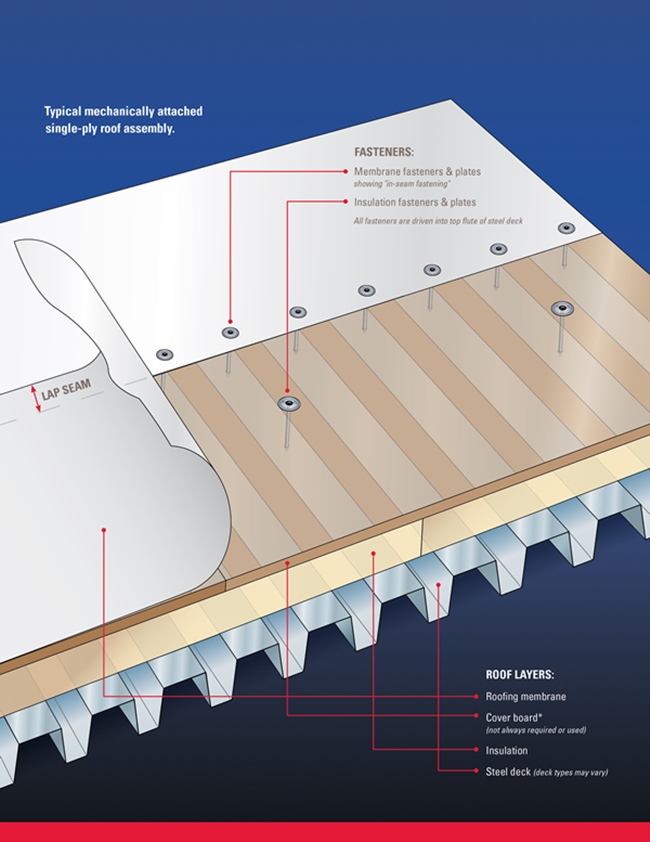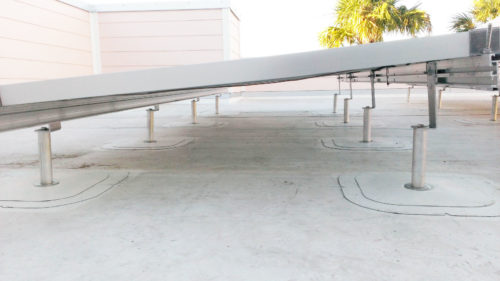Holes in commercial rooftops are often considered the enemy of solar installations. Building owners don’t want them; installers don’t want to make them. So fully ballasted systems have become the norm for commercial roofs. No holes are needed if a solar system is held down by enough concrete blocks.
But today’s commercial roofs are not typically designed to hold a bunch of solar panels, let alone heavy ballast blocks. Although ballast has been the easiest way to quickly install solar on flat roofs, there might be a better approach that would create more potential for solar in the commercial and industrial market.
Holes in commercial roofs don’t have to be scary. With a little roofing 101 and the right products, solar installers can complete projects with less strain on the building and their backs.
 Anatomy of a commercial roof
Anatomy of a commercial roof
To understand how to use penetrations on flat-roof solar installations, one must first know how a commercial roof is constructed. The majority of commercial roofing systems in the United States are mechanically attached, meaning they’re secured to the substrate/roof deck. Many newer U.S. roof decks are made of steel, but wood, concrete and other materials are sometimes used. Rigid insulation is installed on top of the substrate, which is then layered by a high-density cover board (although it’s not always required). Roofs with high-density cover board are generally better able to handle foot traffic and the loading of a PV system.
The top layer of a roofing system is the waterproofing cover. The most common roofing membrane materials include white thermoplastics (PVC or TPO) and black rubber (EPDM). White thermoplastics come in various widths from 3-ft to12-ft wide rolls that are rolled over the cover board and mechanically fastened along their edge. These fasteners drive through the membrane straight into the steel deck. Membrane rolls are overlapped over the fasteners and then fused using hot air to create a watertight seal.
The purpose of a roofing system is to protect what’s under the roof, not necessarily be a happy foundation for solar panels. It’s understandable why building owners and installers don’t want to penetrate into this layered building-protectant. The common concern is voiding the roofing warranty. Though ballast does not penetrate, it does have a few disadvantages.
Ignoring the back-breaking effort needed to move concrete blocks into place, ballast puts an even greater strain on the roof itself. The amount of ballast needed for a 100% ballasted solar system often exceeds the building’s structural capacity. And ill-positioned ballast blocks can grind into a roofing membrane, puncturing the waterproofing layer they were trying to leave unscathed. Furthermore, if there is not a cover-board or hard layer over the insulation, ballast may compress the insulation, creating low spots that invite ponding water and dirt, potentially damaging the membrane and voiding the warranty. Add in the natural expansion and contraction of metal framing that occurs during thermal cycling, and you have a potential recipe for disaster.
In many cases where a fully ballasted system just isn’t an option, mechanical attachments can reduce or completely eliminate ballast from a commercial solar project.
When holes can work
If its decided to skip or limit the amount of concrete, there are roof-warranty-friendly mechanically attached products available. Some mechanical bases, which racking rails attach to, require the installer to core into the insulated layer of a roof to reach the steel deck. Once the base is attached, insulation is replaced and the whole unit is covered by flashing specific to the roofing material. It works, but it’s a time-consuming process.

An Anchor Products installation with its U-Anchor product for asphalt roofs
Rather than coring into a roof’s insulation, there are mechanical base products that simply fasten into the roof deck from the membrane level. No digging is needed.
Anchor Products is a pioneer in the field of mechanically attached products for commercial solar roof installations. Its U-Anchor product sits on the membrane, fastened to the roof deck and covered by a flashing made of the same material as the membrane. Although the company founded in 2010, Byron Loftin, director of sales and marketing, said business has really picked up in the last couple years as people start to understand ballast isn’t suitable in all situations.
“Ballast is what people are comfortable with—not that it’s bad, not that it’s good,” he said. “Anchor Products can accentuate [a ballasted system] by holding it down for seismic, or it can totally get rid of ballast, if designed properly. If someone wants to use ballast with our product, we stand 100% behind them. But there is a better way to do things to open up a bigger potential of the market.”

An Anchor Products installation
Anchor Products has a U-Anchor attachment for every type of commercial rooftop—asphalt, coatings, TPO, PVC and EPDM included. The company’s founder Joel Stanley has over 35 years’ experience within the roofing industry and uses his expertise and rolodex to ensure no U-Anchor voids a roof’s warranty.
“We’re the only product out there accepted by every roofing manufacturer not to void a warranty. We can get a letter for each project that includes the solar system in the warranty,” Loftin said. “Every roof that we do, we make specifically for that roofing application.”
This means that if a solar installer needs anchor products for a Johns Manville-manufactured roof, Anchor Products will make its U-Anchor out of Johns Manville-produced membrane material and Johns Manville-approved fasteners. The same goes for a GAF roof or a Firestone roof. As long as the U-Anchor is installed correctly, the roofing manufacturer should have no concerns.

The OMG PowerGrip
OMG Roofing Products’ PowerGrip line of anchoring products works in a similar fashion to Anchor Products’. Chris Mader, codes and approvals support engineer at OMG, explained his company’s products are frequently designed to be used in conjunction with ballast to minimize on-the-roof movement that ballast can’t completely prevent.
“All of our products have to be bolted into that deck,” he said. “You want the structural load on the deck, not on the waterproofing or membrane layer.”
PowerGrip products attach to the roof deck via the same fasteners the roofing manufacturer uses, and are made from the same material installed on the roof for 100% compatibility. After heat-welding the PowerGrip in place, a protruding stud is the “optimal perch” for securing L-foot brackets provided by mounting system manufacturers. OMG PowerGrips can be used on any commercial roofing system including TPO, PVC, EPDM, modified-bitumen and BUR.

A solar array with OMG PowerGrip attachments
“To maintain the roof warranty, the roof system manufacturer will, at a minimum, want to know about the project up front, that their installation requirements have been met and that the product was installed by an authorized applicator,” Mader said.
Both Anchor Products and OMG Roofing Products said there’s often confusion on both sides of a solar installation on a commercial rooftop—many solar installers don’t understand how roofs are put together and roof manufacturers don’t understand how solar is attached. While ballast works in many cases, drilling a few holes into a commercial roof can bring solar installations to more roofs without voiding any roof warranties or having waterproofing worries, provided the roof system manufacturer is involved in the process.
“We have nothing against ballast,” Loftin said. “But there’s a big sector of the market that is untouched. If it’s designed properly, we’re cost-competitive with ballast. If ballast is $2.50, we’re certainly more than $2.50, but you’re not paying some guy $20 an hour to carry that ballast across the roof.”




Thanks a lot for this article.
Are there any standards, guidelines or requirements for the mechanical fastening regarding the load capacity and especially regarding the correct and securely sealing of the penetration point?
I enjoyed the video and have always like Iron Ridge products. I have fairly large project (277,000 S/F) we are doing a PVC roof over prior to solar racking. Most of the deck is metal and I planed on anchor system for racking. However some of the roof is concrete deck and the PVC is fully adhered, will I have to ballast these sections or is there another solution?
Thanks for this video. I was hoping to see many more comments. I recently custom-designed a penetration system for a membrane roof. I’m interested to learn more about these pre-fabbed solutions.
Salut,
I have a question regarding this article. I would like to know if the U-anchor and the OMG Power Grip can be used on concrete flat roofs? If so, how do we air-heat both products onto the concrete roof?
Great article. Thank you for your time.
Merci
Joseph F.
Hi Thanks for the article on anatomy of a commercial roof. Can you please give me your recommendations on type of roof membrane, type of roof anchors for a flat residential house in San Francisco- Victorian home with existing tar and gravel roof and wooden roof joists? I am planning to install solar at a future date, after I put in a new roof. I have always had tar and gravel roofs on the building, but I have learned that a “roll type” roof on a flat roof is a better alternative for solar. The main reason is the problem of penetration and the possibility of leaks with the traditional tar and gravel. I would like to know if there is an anchor system that can be installed at the same time a tar and gravel roof is put down. Please help.
Thanks
Craig
There’s got to be a better way! We are looking for a system that bolts across the width of a roof fixed into the parapet walls without puncturing the roof membrane in any way. If you know one please write me trevorleigh@gmail.com